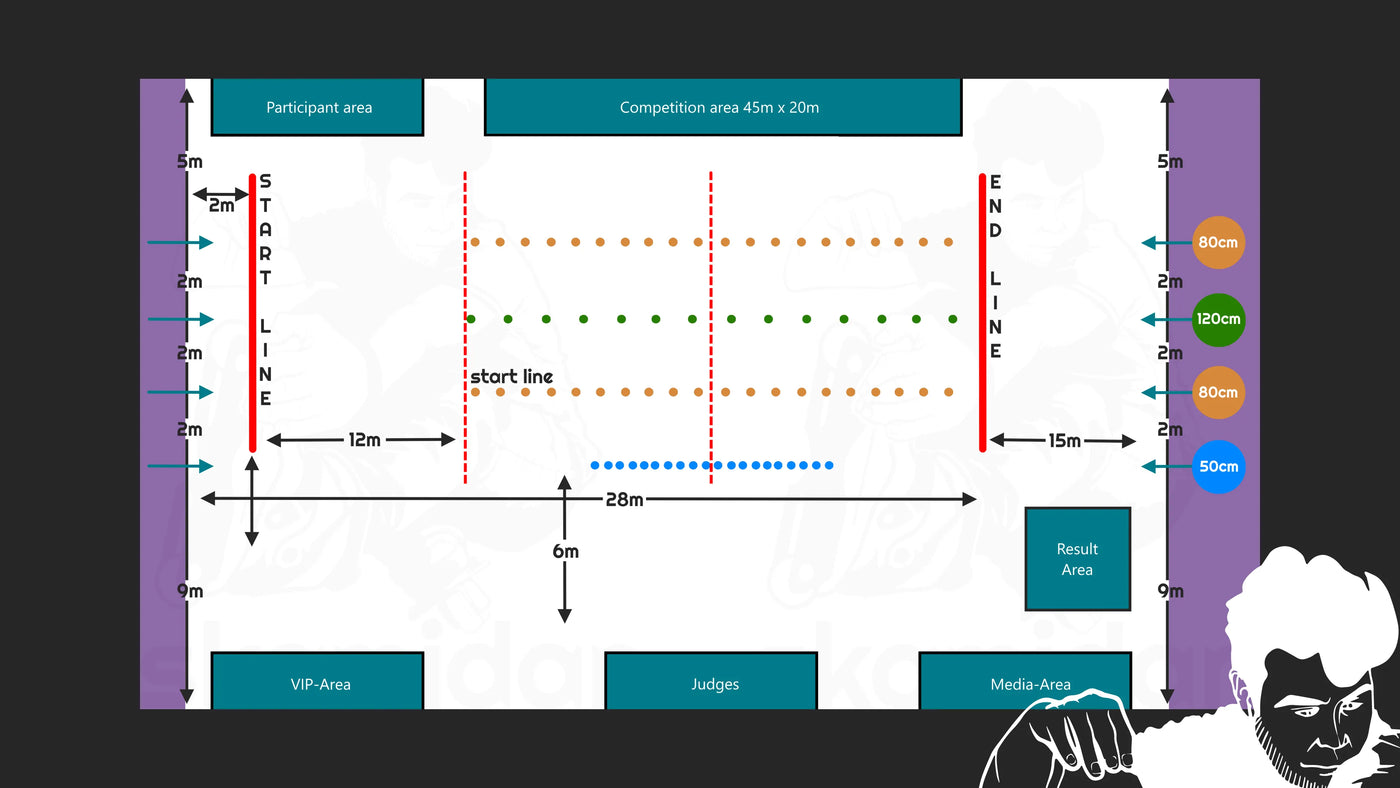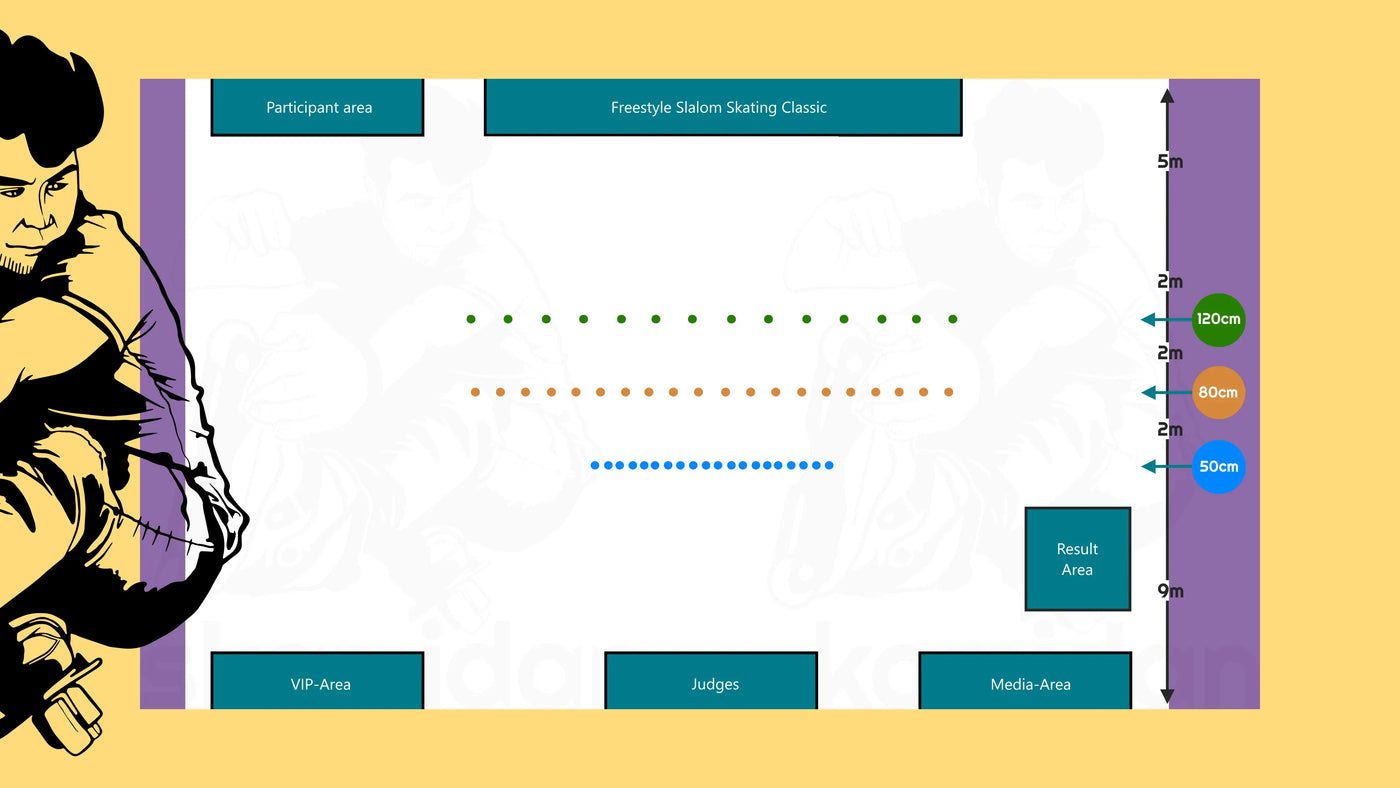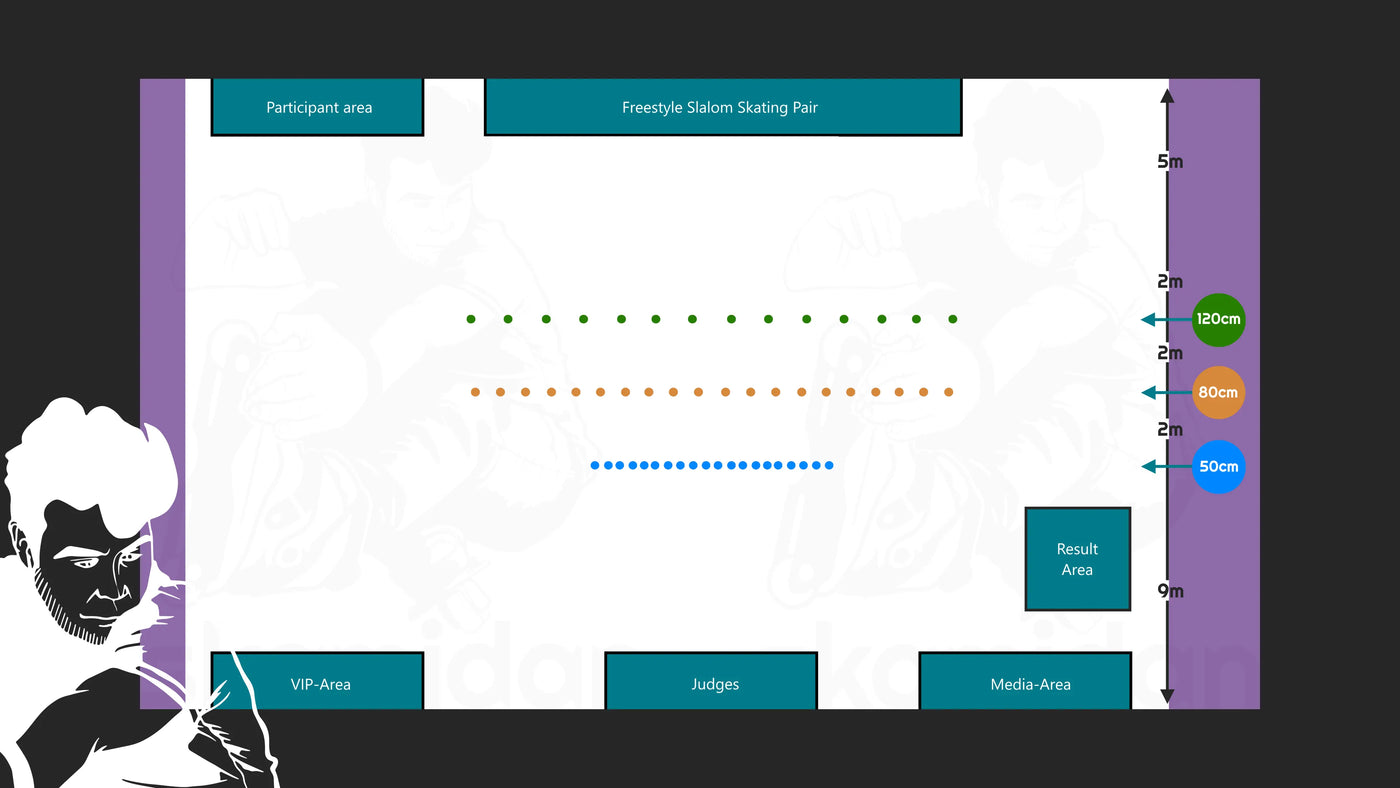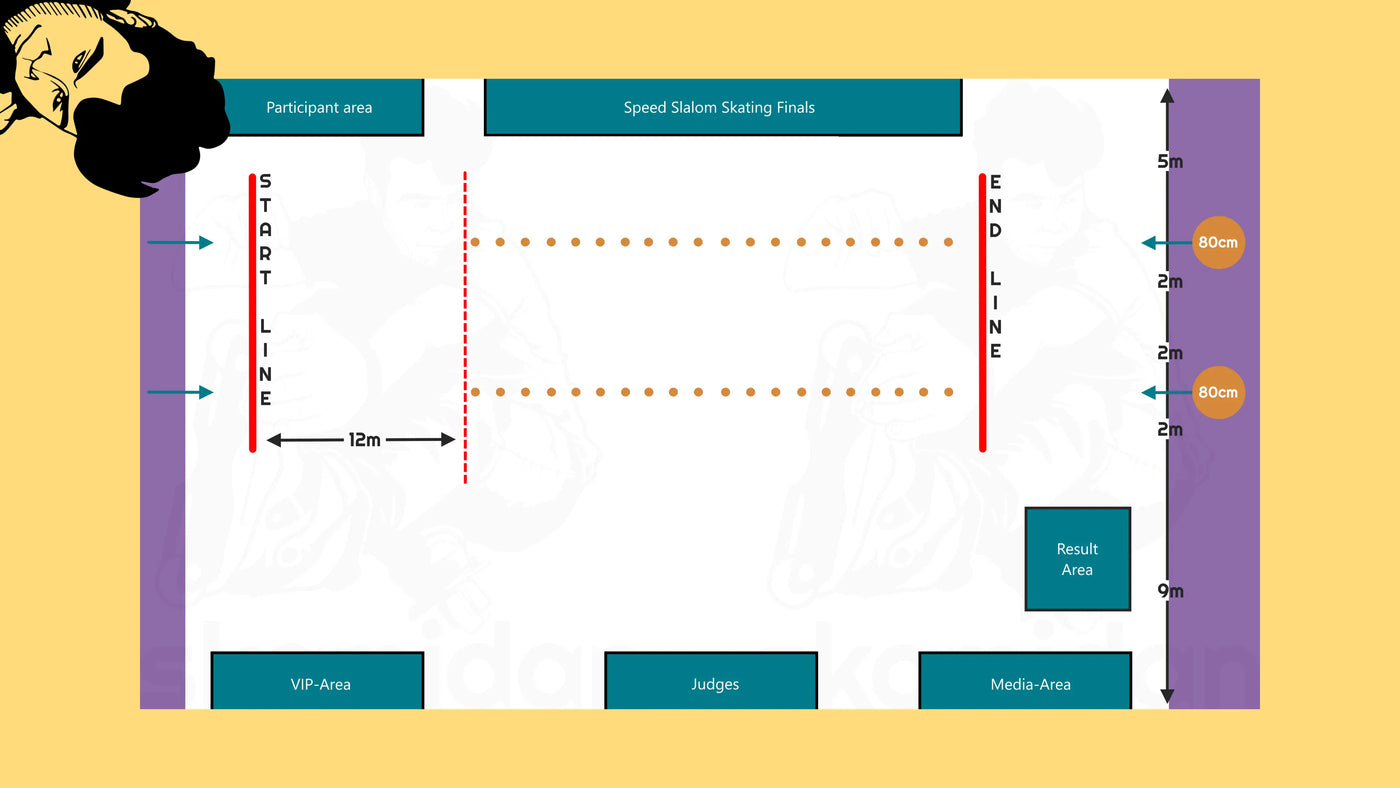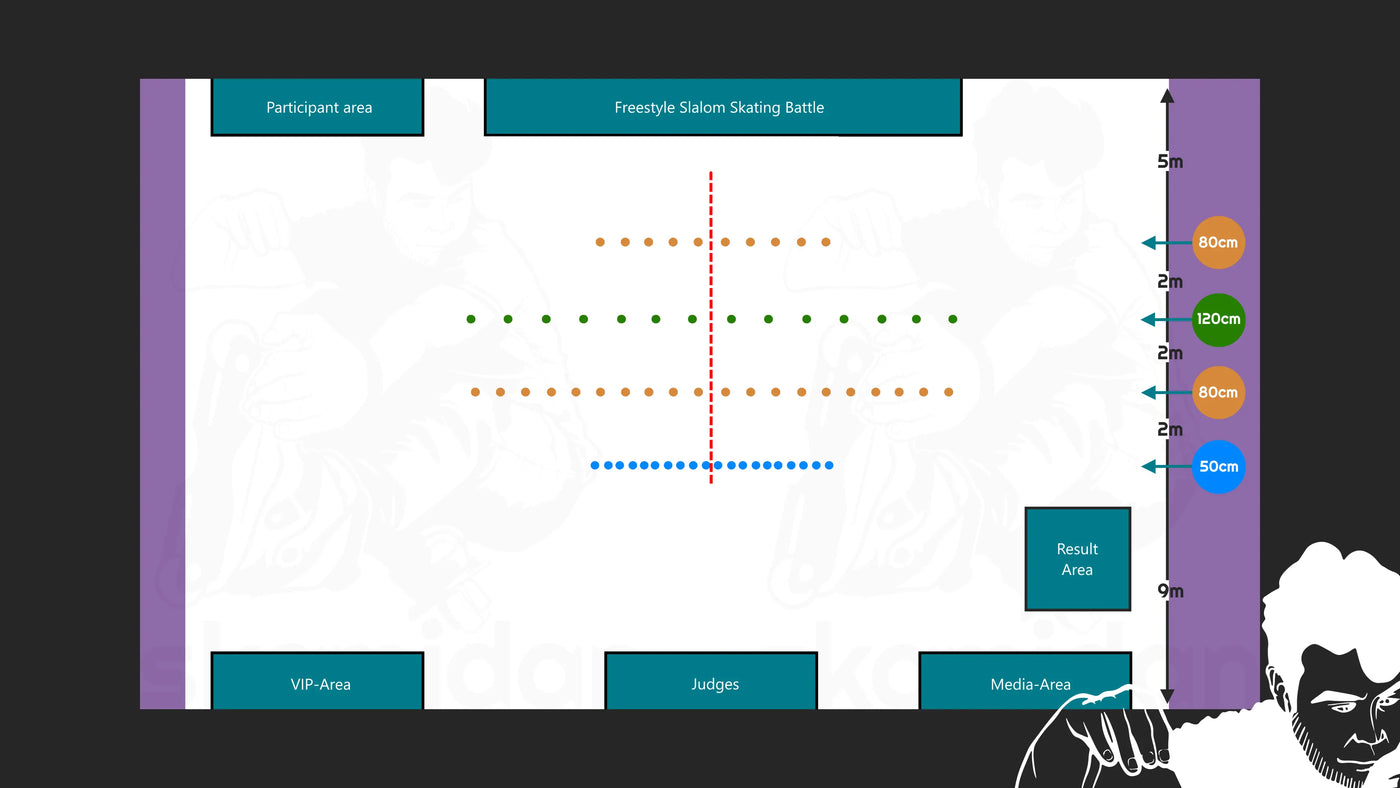Inline Freestyle Slalom Skating
Basics, Rules and Things to know
When people hear the term Inline Freestyle Slalom Skating for the first time, they often think of simple zigzag movements through a line of cones. But that’s just the tip of the iceberg — and the so-called “Fish” (sometimes referred to as “Snake” depending on the variation) is just one of hundreds of tricks this fascinating discipline has to offer.
Freestyle Slalom Skating is far more than it appears at first glance:
It's a technically demanding discipline with its own complex set of rules.
Before we dive deeper into the world of tricks, techniques, and competition formats, we invite you to get a first impression through the following video — and experience the aesthetics, dynamics, and creativity of this sport for yourself.
The facets of Inline Freestyle Slalom Skating
Inline Freestyle Slalom Skating
Overview and disciplines
As a sub-area of Freestyle Skating, which in turn belongs to the larger family of Inline Skating, Freestyle Slalom Skating is divided into many different main categories.
Please select the category that interests you most below.
- The basics of inline freestyle slalom skating
(Cones, disciplines and setups) - Freestyle Slalom Skating Classic
(classic freestyle slalom skating) - Freestyle Slalom Skating Pair
(Pair Slalom Skating) - Speed Slalom Skating
(Time Slalom Skating) - Freestyle Slalom Skating Battle
Freestyle Slalom Skating is a fascinating mix of technique, creativity and expression
Whether solo, in pairs, head-to-head, or against the clock – every discipline comes with its own unique challenges.
Precision, balance, and style are always at the heart of the sport.
By embracing slalom skating, you'll discover not only new tricks but also a vibrant and inspiring community.
From your first "Fish" to a polished choreographed routine, it's a journey of movement and personal growth.
Freestyle Slalom is more than just a sport – it's a lifestyle on wheels.
Cones, disciplines and setups
The basics of Inline Freestyle Slalom Skating
All four disciplines of Freestyle Slalom Skating have one thing in common:
They require slalom cones (also called kegs or cones) that are arranged on the ground in a specific pattern.
Depending on the discipline, the distance between the cones varies, but it is always standardized and follows fixed regulations.
Official Cone Dimensions:
- Height: 7.6 cm to 8.0 cm
- Bottom Diameter: 7.4 cm to 7.5 cm
- Top Diameter: 2.5 cm to 2.7 cm
Competition areas must also meet certain standards – you’ll find an illustration of this further down the page.
To help you set up your cones quickly, easily, and correctly for practice without wasting time each session, we’ll show you how to do it step by step in the following video.
Alternatively, you can also read the detailed instructions right here in the article.
The Cone setups at a glance
Before diving into tricks and tutorials, it's worth taking a closer look at the different disciplines — and their common features.
A key element is the three-row cone setup, as illustrated in our graphic (the colors also match those used in our videos and photos for easier orientation):
- 🟩 Green row: 14 cones, spaced 120 cm apart
- 🟧 Orange row (standard): 20 cones, spaced 80 cm apart
- 🟦 Blue row: 20 cones, spaced 50 cm apart
The lateral distance between each row is exactly 2 meters.
Measurements are always taken from cone center to cone center.
What makes good inline slalom skating?
As shown in the first illustration, the following skills are especially important in inline freestyle slalom skating:
- Agility
- Maneuverability
- Precision
- Control
- Responsiveness
- Direct Power Transmission
To optimally develop these skills, special freestyle slalom inline skates are used — also known as freestyle skates or freeskates.
These skates are characterized by:
- A short frame length (wheelbase)
- The option of a rocker setup, which significantly increases agility
- A rigid and precise boot construction to guarantee maximum control and responsiveness
Classic Freestyle Slalom Skating
Inline Freestyle Slalom Skating Classic
In Inline Freestyle Slalom Skating Classic, participants prepare an individual choreography to music of their choice.
This discipline combines technically demanding tricks with creative expression, rhythmic movements, and dance-like elements.
It’s a category where skill, creativity, and personality are equally important.
Cone-Line Setup
For a Classic performance, three slalom rows (cone-lines) are used.
The lateral distance between the rows is standardized at exactly 2 meters, measured from cone center to cone center.
The rows must be aligned so that their midpoints are perfectly aligned with each other and centered towards the judges’ table.
From the judges’ perspective, the layout is as follows:
- 🟦 20 cones, each 50 cm apart (marked in blue)
- 🟧 20 cones, each 80 cm apart (marked in orange)
- 🟩 14 cones, each 120 cm apart (marked in green)
Choreography sequence
Participants have 105 to 120 seconds (maximum 2 minutes) for their performance.
The timer starts when the music begins, which is played as soon as the skater signals they are ready.
The run ends automatically with the music or by an active signal from the participant.
Judging criteria – technique & expression in harmony
The performance is evaluated based on two key aspects:
Technical skill and artistic expression.
A total of 130 points can be achieved (including up to 10 bonus points).
Technical skills (10–60 points):
The execution and difficulty of the tricks performed are judged.
The cleaner, more precise, and complex the tricks are, the higher the score.
Artistic skills (0–60 points):
This focuses on the overall impact of the performance:
Movement in sync with the music, body language, sense of style, originality, and the harmonious blend of freestyle tricks, dance, and energy all play a key role.
This discipline perfectly represents the diverse nature of freestyle slalom skating – a fascinating mix of sport, rhythm, and personal expression.
Pair Slalom Skating
Inline Freestyle Slalom Skating Pair
The Freestyle Slalom Skating Pair discipline follows the same basic rules as Classic Freestyle Slalom (solo).
The key difference:
Two skaters perform a synchronized choreography together, showcasing technical and artistic harmony.
The performance thrives on harmony, precision, and creative interaction — through mirror movements, parallel trick sequences, or alternating elements.
More time for more expression
Compared to the solo discipline, pairs are given more time to present their choreography.
Performing in sync with a partner requires even more precise coordination.
Same Cone-Line Setup as Solo
The classic three-row cone setup is used for pair competitions as well, exactly like in Inline Freestyle Slalom Classic.
The distance between rows remains 2 meters, measured from cone center to cone center.
The rows are aligned so their midpoints are both aligned with each other and centered towards the judges’ table.
Cone-Line Setup (from judges’ perspective):
- 🟦 20 cones with 50 cm distance (blue)
- 🟧 20 cones with 80 cm distance (orange)
- 🟩 14 cones with 120 cm spacing (green)
Choreography Sequence – In Sync with the Rhythm
For the Freestyle Slalom Skating Pair choreography, participants have a time frame of 160 to 180 seconds — up to a maximum of three minutes.
The music starts as soon as both skaters signal to the event staff that they are ready. The official timer begins simultaneously with the music.
The performance ends either with the conclusion of the music piece or when the skating duo actively signals that their run is completed.
Competition evaluation – technique, expression & synchronization
The judging of the pair performance is based on three main categories, with a total of up to 200 points possible:
Technical skills (10–60 points):
The difficulty of the tricks performed, along with their clean and precise execution, is assessed.
Artistic expression (0–70 points):
This focuses on the harmony between music and movement, creative choreography, body language, style, and the integration of freestyle elements, rhythm, and energy.
Synchronization (0–70 points):
A central criterion of this discipline:
The perfect coordination between both skaters — whether in identical, mirrored, or complementary movements.
Variations such as forward/backward, left/right, or heel/toe are allowed — what matters is the precise timing and spatial alignment of their performance.
The pair competition format demands not only individual skill but also a strong sense of teamwork and precision, making it one of the most impressive disciplines in freestyle slalom skating.
Time Slalom Skating
Inline Speed Slalom Skating
In Speed Slalom Skating, participants aim to skate through a line of cones (or slalom markers) as fast as possible — all while balancing on one foot.
Speed Slalom is divided into two phases:
- A qualification phase based on the individual time trial (all participants).
- A final phase based on a knockout system of the fastest competitors in the individual time trial.
For the time trials, where each skater tries to set their best time, we optionally use one or more cone lines.
In the final phase, where the finalists compete head-to-head, we use two parallel cone lines, separated by a bar (cone catcher).
Both final-phase lines are positioned parallel to each other. The midpoint of each line must be aligned both with the midpoint of the other line and the center of the judges’ table.
Cone Line Setup (from the judges’ perspective):
- 🟧 20 cones with a distance of 80cm each (shown in orange).
Competition rules – Speed Slalom Skating in detail
Penalties & Run Scoring
In Speed Slalom, it’s not just about speed but also precision. The following rules apply for errors during a run:
- For each missed, moved or completely shot pin, a penalty time of +0.2 seconds is added to the running time.
- A cone is considered to be displaced when its original center becomes visible - that is, when it has shifted so far that its original position is exposed.
Important:
- If a skater receives more than four penalty times in a run, the run will be deemed invalid.
- An invalid run may not be repeated.
Qualification phase – the time trial
In the qualification round, each skater has two time trials available.
The better of the two times counts towards the official ranking.
Based on these times, the fastest skaters qualify for the knockout round.
The number of final spots depends on the total number of participants and is determined by the head judge.
Possible final rounds include:
- 4
- 8
- 16
- 32
- or 64 skaters
Final Phase & Grand Finale – The Knockout Duel for Victory
In the final round, the qualified skaters face off in a knockout system.
The principle is Best of Three – the first skater to win two runs advances to the next round.
The losing skater is eliminated from the competition.
Duel pairings in the first round:
The classification is based on the qualification times according to the following scheme:
- 1st place vs. last place in qualifying
- 2nd place vs. second to last place
- 3rd place vs. third to last place
- etc.
Finals & placement runs:
- The two winners of the semi-finals will compete against each other in the grand final for first place.
- The losers of the semi-finals will compete in a small final to determine third place.
This direct duel format delivers pure excitement and demands maximum focus, precision, and mental strength from the participants – every single run can decide the outcome.
Technical duels at the highest level
Freestyle Slalom Skating Battle
In Freestyle Slalom Skating Battle, three to four skaters face off directly in a group.
In these thrilling technique duels, it's all about outperforming the competition with the best tricks.
Over multiple rounds, participants take turns showcasing their top moves –
the goal: to technically outshine the opponents.
- The two best skaters per group qualify for the next round.
- The ranking is determined solely by direct comparison within the battle group,
not by a points system like in Classic.
Battle Area: Four Cone Lines in Action
The competition area for Battle is the same as in Freestyle Slalom Classic,
ith the addition of a fourth cone line.
This expansion offers even more space for creative moves and individual styles.
Cone Setup (from the judges’ perspective):
- 🟦 20 cones, each 50 cm apart
- 🟧 20 cones, each 80 cm apart
- 🟩 14 cones, each 120 cm apart
- 🟧 10 additional cones with 80 cm
All lines are spaced 2 meters apart, measured from cone center to cone center.
The midpoints of all lines are aligned symmetrically with each other and the center of the judges’ table.
Competition Procedure & Judging in Inline Freestyle Slalom Skating Battle
Group Formation
Skaters are assigned to groups based on their current international world ranking.
Participants without a ranking are added randomly at the end of the list.
Each group consists of a minimum of 3 and a maximum of 4 skaters.
If the total number of participants doesn't allow for even groups,
the head judge may create pre-qualification groups—in exceptional cases with up to 5 skaters per group.
Group numbers based on participant count:
- 2–16 skaters → 4 groups
- 18–23 skaters → 6 groups
- 24–32 skaters → 8 groups
- etc.
Competition Flow – Structure & Runs
All skaters in a group receive the same number of runs.
Each run lasts 30 seconds, starting from the moment the skater touches the first cone.
Once time is up, the run is no longer evaluated, even if the trick is still being completed.
Number of runs per phase:
- Preliminary round to quarterfinals: 2 or 3 heats (at the discretion of the referee)
- Semifinals: always 3 runs
- Consolation final (3rd & 4th place): 2 runs + 1 last trick
- Final (1st & 2nd place): 3 runs + 1 last trick
Best Trick & Last Trick – The Showdown Decider
Best Trick (in case of a tie):
If a battle ends in a tie, the jury can call for a Best Trick showdown.
Each skater shows their best trick to decide the round.
- Everyone has a maximum of 2 attempts of 30 seconds each
- Note: If the first attempt takes longer than 10 seconds, the second attempt will be skipped
- Only the best attempt will be evaluated by the jury
Last Trick (Final rounds & Consolation Final):
The Last Trick is an additional run used in final rounds.
It consists of one trick, repeated as many times as possible.
- Here too: 2 attempts of max. 30 seconds each
- If the first attempt takes longer than 10 seconds, no second attempt is allowed
- Only the best attempt counts
- The jury takes into account all regular runs as well as the last trick to determine the ranking.
The Battle format delivers excitement, direct competition, and emotional highlights.
Those who combine technical excellence with style, creativity, and mental strength have the best chances of advancing round by round.

